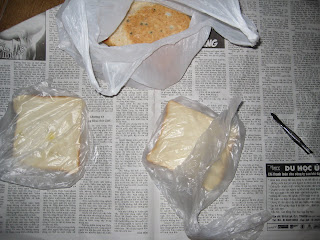
Graph of mould growth in Trial 1, using mould from stale bread

Graph of mould growth in Trial 2, using mould from blue cheese
I figure a lot of errors could have occured here.
1. I couldn't get the EXACT same amount of mould on each slice. I'm only a clumsy human. The stale bread mould grew in round clusters, almost equal in size so I put one of those on each slice. But I don't know how many spores I ended up putting there, or their reproductive ability. The blue cheese had veins of mould that I had to extract, so it was even harder. Varying densities of the veins and all. I spread the mould out into two square centimetre shapes, but that was only equal to the nearest square centimetre, eh. If it grew, it grew.
2. Nature of placement.
Pantry: flat, side by side, high shelf. Dark unless someone walked in an turned on the light.
Fridge: flat, side by side, low shelf. Also dark unless someone opened the fridge.
Freezer: vertical, pressed one to the other in a pile. It's pretty crowded in our freezer. We haven't got a light, but I suppose the light from the kitchen would get in if anyone opened it.
Hence, varying exposure to light and oxygen.
Furthermore, there's varying humidity, which I couldn't control. Mould NEEDS moisture, but I couldn't give it to them. In the freezer it's very dry. But I could see condensation inside the fridge bags, which must have meant that they had moisture available. But ALL TEN slices that were either in fridge or freezer didn't grow at all. They didn't like me. :(
3. Limit of reading. I could only measure to the nearest square centimetre with my transparent grib. *wobble wobble wobble*
Thus it ends, my tasty tenacious little lemon drops.
"It has been shown in this experiment that surrounding temperature affects rates of mould growth. The hypothesis was supported in part by the results taken. Mould in room temperature thrives and mould in freezing conditions does not grow but remains dormant; these observations support the predicted results. However, mould kept at 4°C did not show any growth, when it was predicted that it would be able to grow at least minimally. If this part of the hypothesis is to be re-examined, human errors and errors of reading must be taken into account, and a more accurate method must be used. A general statement can be made that mould colonies find it more difficult to grow when the temperature of the surrounding environment is lower."
Guess what. No turtles. ;D












